Other than the triangular road works warning sign, road works signs are temporary and yellow, or yellow and red in colour.
You will often encounter road works being performed on single carriageways where traffic lights are used to manage traffic. Road works that utilise temporary traffic lights should be authorised by local councils to obtain permission for placement and duration.
Road works that have been granted permission by appropriate authorities are lawful and all road signs and traffic lights must be treated in the same respect as fixed versions. Such signs and signals are enforceable by law and may see a motorist incur a fine and penalty points on their licence.
This section covers road works signs used on various UK roads and is required to learn for the theory test.
Road signs theory test quiz
Once you have familiarised yourself with the road works signs and temporary yellow road signs located on major routes, take a look at our road sign test quiz and test your knowledge to see if you are ready for this part of the theory test.
Common Road works signs
Throughout your driving career you will encounter road works on many occasions. Typically on single carriageway roads you will often see a road works warning sign initially to warn of the hazard ahead, followed by the ‘When red light shows wait here’ sign. These temporary traffic lights must be treated the same as static traffic lights. A white plate detailing the distance to the road works or the type of work being carried out may also accompany the road works warning sign.
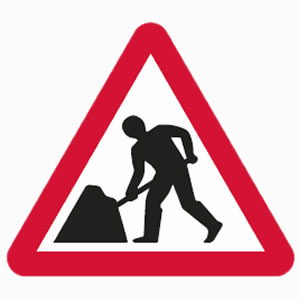
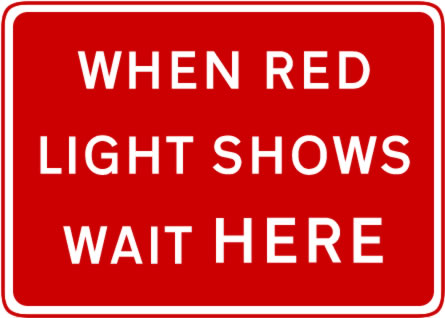
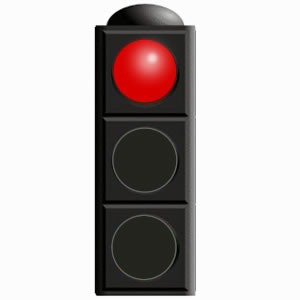
Temporary road signs on major routes
Temporary yellow road signs are often situated on major routes such as dual carriageways and motorways to direct traffic into appropriate lanes due to road works.
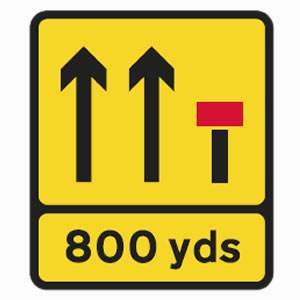
Lane ahead closed sign
Lane on the right is closed 800 yards ahead. Other lanes remain open to all traffic.
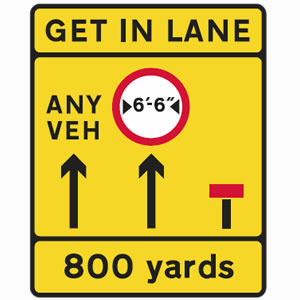
Get in lane sign
Get in lane road works sign. Left lane used for any vehicle, centre lane has a width restriction and right lane closed 800 yards ahead.
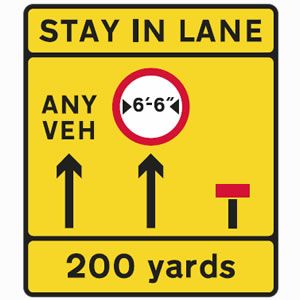
Stay in lane road sign
Lane closure 200 yards ahead. Centre lane has width restriction. Vehicles wider than 6 feet and 6 inches must use left lane. Left side lane is for any vehicle.
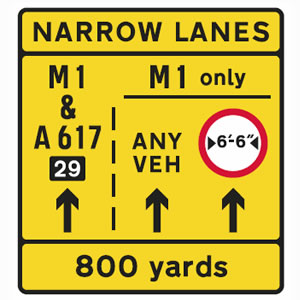
Narrow lanes ahead sign
The near-side left lane should be used for traffic leaving the motorway at the next junction (A617) and can also be used for traffic staying on the motorway. Maximum width of vehicles in right-side lane is 6 feet, 6 inches.
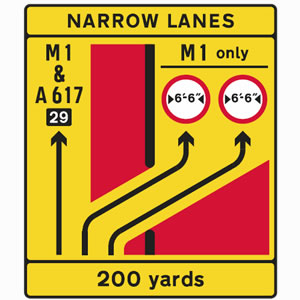
Motorway traffic lanes divide sign
The near-side left lane leads to an exit junction and may also be used to stay on the motorway. Right-hand lanes cross the carriageway. Areas shown in red are closed to traffic.
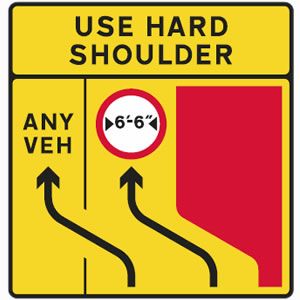
Use hard shoulder sign
Traffic lanes move over to the left to make use of the hard shoulder which is usually illegal to drive in unless in an Active Traffic Management area. Vehicles in the right lane that exceed the width stated must move over to the left.
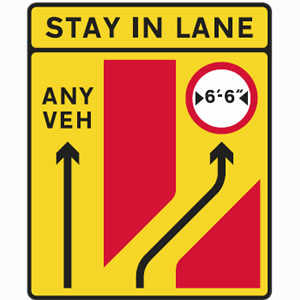
Traffic lanes SEPARATE sign
Two adjacent traffic lanes separate. The right-hand lane separates over to the right but remains on the same carriageway side.
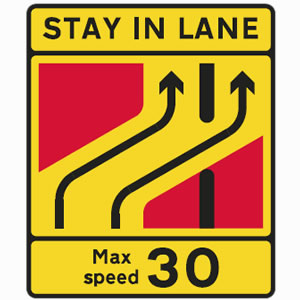
Traffic lanes separate advised speed limit sign
Two traffic lanes move over to the right. One lane remains on the same carriageway side whilst the other crosses the carriageway. Where the lanes move, the advised speed limit is 30 mph.
Motorway traffic cylinder
Where opposing flows of traffic operate (contra-flow), traffic cylinders are used to separate the adjacent lanes of traffic. For further information on contra-flow systems and how they work, see contraflow systems.
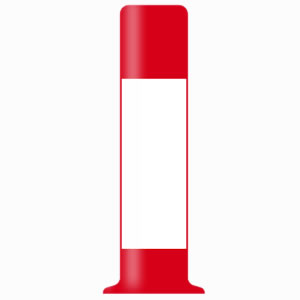
Repeater temporary road works signs
The signs below show the distance over which the reduced number of lanes continue through the road works. The signs are repeated at regular intervals, typically every ½ mile. In the examples shown below, there are no lane restrictions such as a width limit. The vertical black line indicates that the left-hand lane is the hard shoulder.
The white downward-pointing arrow indicates a contra-flow traffic lane separated by traffic cylinders (detailed to the right). Where the contra-flow lane is separated by a physical barrier or a buffer lane (a lane closed to traffic), the white arrow is not shown. Other temporary repeater road works signs may show restrictions such as a width or weight restriction for example.
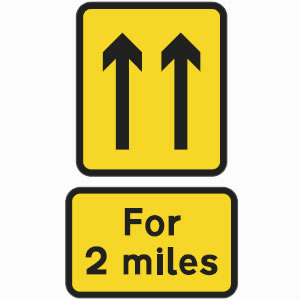
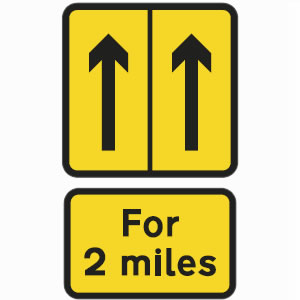
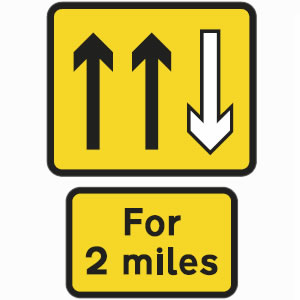
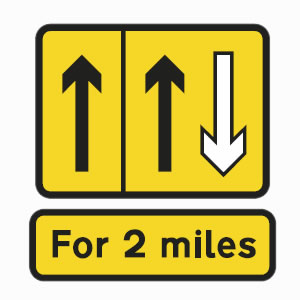
Temporary slip road signs for joining and leaving at junctions
Where traffic joins or leaves at junctions, previous signs that are permanent may be temporarily changed due to road works. How you join or leave from a junction – lane drop, lane gain and traffic merge, may also be temporarily changed due to road works.
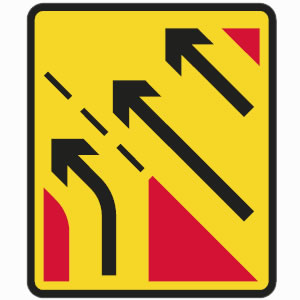
Temporary yellow slip road sign
Temporary road works slip road sign for those joining the carriageway. Slip road joining main carriageway where carriageway increases from two lanes to three (lane gain)
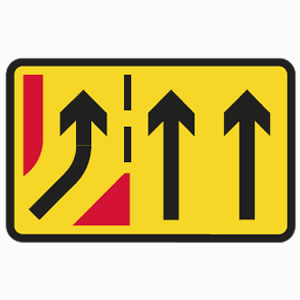
TEMPORARY YELLOW SLIP ROAD SIGN
At the same junction where a slip road joins the main carriageway, this sign is for motorists already on the main carriageway.
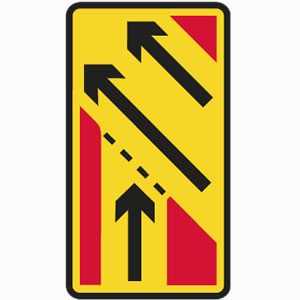
Merge with carriageway sign
Slip road joining main carriageway with ‘give way’ markings where motorists on slip road must merge with main carriageway.
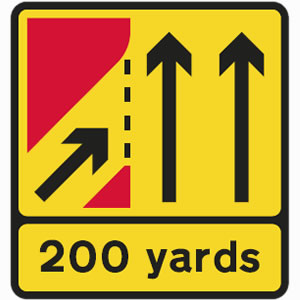
Road joining carriageway sign
At the same junction, this is the sign motorists already on the main carriageway will see, warning of the junction and slip road merging onto the carriageway.
Road signs theory test quiz
Once you have revised the road works signs and temporary yellow road signs located on major routes, take the road sign test quiz and test your knowledge to see if you are ready for this part of the theory test.
Other types of road signs
In order to pass the driving theory test, you’ll need to study all UK road signs and understand their meaning.
- Warning road signs
- Order road signs
- Blue road signs
- Brown road signs
- White road signs
- Speed limit signs
- Direction signs
- Low bridge signs
- Parking and no parking signs
- Bus lane and bus stop signs
- Road markings and lines



